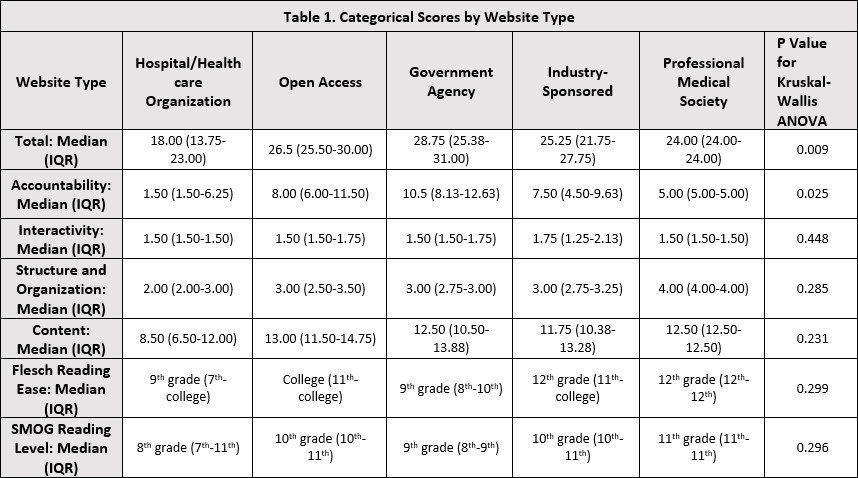Patient Resources For Major Lower Extremity Amputation On The Internet Are Qualitatively And Quantitively Poor - Reader Beware!
Zachary Harbin, BS1, Wesley Clothier, BS1, Preston Tolbert, BSA1, John Treffalls, BS1, Qi Yan, MD2, Mark Davies, MD2.
1University of Texas Health Science Center San Antonio, Long School of Medicine, San Antonio, TX, USA, 2University of Texas Health Science Center San Antonio, San Antonio, TX, USA.
OBJECTIVES: The internet has become a leading resource where patients research medical information and use this information in shared decision making with their providers. This groundbreaking study seeks to evaluate the quality and readability of patient resources for major amputation of the lower extremity (AMP).
METHODS: Searches were performed using the search terms “Lower Limb Amputation” and “Amputation” on Google, Yahoo, Bing, Yippy, and Dogpile. The top 40 websites from each search engine were screened for exclusion (duplicate websites, non-relevant information, resources not intended for patients) and evaluated independently by two reviewers for accountability, interactivity, structure/organization, and content with discrepancies resolved by consensus. Four indices were used to evaluate readability. Statistical analysis was performed using Rstudio with ANOVA.
RESULTS: 35 websites met inclusion criteria, including 15 hospital/healthcare organization websites (43%), 11 open access (31%), 4 government agency (11%), 4 industry sponsored (11%), and 1 professional medical society (3%). Qualitatively, websites performed well in describing the post-operative recovery process (94%), prosthetics (97%), pain management (80%), mental and phycological support (77%), phantom limb pain (74%), post-operative limb-specific infection (69%), and wound care (63%). However, few websites discussed flexure contracture (43%), hematoma (37%), systemic postoperative complications such as MI and stroke (34%), alternative options to amputation (26%), risk of re-amputation (26%), prevalence/incidence of lower extremity amputation (17%), prospects of ambulation (11%), and risk of amputation on the contralateral limb (9%). Quantitative analysis showed that median scores were 6.50 out of 16.00 for Accountability (IQR: 2.50-10.00), 1.50 out of 5.00 for Interactivity (IQR:1.50-1.50), 3.00 out of 4.00 for Structure/Organization (IQR: 2.00-3.00), 11.50 out of 23.00 for Content (IQR: 8.00-13.75), and 24.00 out of 48.00 for Total Score (IQR: 18.25-27.25). Government agency websites had the highest total score and accountability, while hospital/healthcare websites had the lowest total score and accountability (total score: median 28.75 vs 18.00, p=.009, accountability: median 10.5 vs 1.5, P=.03) (Table 1).
CONCLUSIONS: Websites on major amputation of the lower extremity are variable in the information they provide and further research regarding preoperative patient understanding should be conducted. Providers should seek to actively fill this information gap, particularly when communicating postoperative complications.

Back to 2021 ePosters
